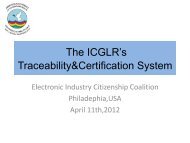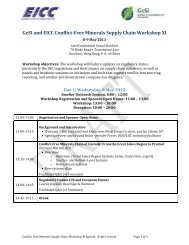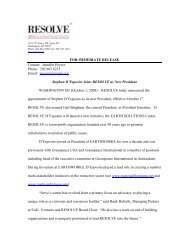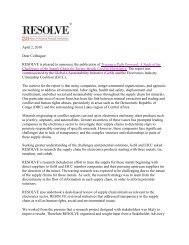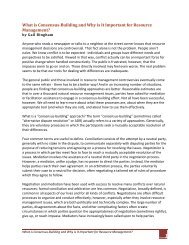Toward SuSTainabiliTy: The roleS and limiTaTionS of ... - Resolve
Toward SuSTainabiliTy: The roleS and limiTaTionS of ... - Resolve
Toward SuSTainabiliTy: The roleS and limiTaTionS of ... - Resolve
Create successful ePaper yourself
Turn your PDF publications into a flip-book with our unique Google optimized e-Paper software.
Chapter 2: Actors – NGOs <strong>and</strong> Civil Society 26who want to move toward certification <strong>and</strong> providethem with technical assistance to do so. Althoughthe supply may not be fully certified at first, thegoal is to provide retailers with access to timber<strong>and</strong> wood products generated by forests that areactively <strong>and</strong> demonstrably working toward certification<strong>and</strong> to provide a long-term responsiblesupply once they are certified (Overdevest, 2004).NGOs also have created buyers’ groups to helpretailers find responsible suppliers. <strong>The</strong> first suchgroup was the 1995 Plus Group in the UnitedKingdom, <strong>and</strong> later the Certified Forest ProductsCouncil in the United States. Today, the WWFGlobal Forest <strong>and</strong> Trade Network (GFTN) is amajor player in this role. <strong>The</strong>se organizationsare nonpr<strong>of</strong>it NGOs that pool FSC retailers <strong>and</strong>producers to help retailers meet their dem<strong>and</strong>for certified product. <strong>The</strong> GFTN, for example,strives to develop trading networks by creatingregional organizations that maintain informationabout producers <strong>of</strong> responsible forest products,including where they are located <strong>and</strong> the speciesthey sell. Buyers identify the product lines <strong>and</strong>source needs <strong>of</strong> the retailers seeking certifiedwood (Overdevest, 2004). <strong>The</strong> GFTN providestechnical guidance to companies on how to buyresponsible forest products <strong>and</strong> to forest ownerson how to move toward forest certification. 16Drivers <strong>of</strong> Civil SocietyParticipation in St<strong>and</strong>ards<strong>and</strong> Certification SystemsNGOs, foundations, <strong>and</strong> other civil society organizationsare highly diverse in their interests, values,<strong>and</strong> norms, <strong>and</strong> have been driven to participatein the development, implementation, criticism,<strong>and</strong> evolution <strong>of</strong> certification systems at differenttimes <strong>and</strong> in different ways. Perhaps the primarygeneral conclusion that can be drawn is that theirparticipation <strong>and</strong> support is conditional: <strong>The</strong>ysupport <strong>and</strong> engage with certification not becauseit is the norm, but because they see it as a potentialtool for advancing <strong>and</strong> accomplishing theirgoals. However, they will withdraw or respondif or when it fails to prove useful. At the sametime, a surprising portion <strong>of</strong> the NGO communitydoes not engage with certification at all; it simplyhas not been part <strong>of</strong> the strategic focus <strong>of</strong> manyNGOs.Like businesses, NGOs need to survive. Becausethey are mission-oriented rather than pr<strong>of</strong>it-oriented,there may be a tendency to think <strong>of</strong> NGOdrivers only in terms <strong>of</strong> achieving their overallsocial <strong>and</strong> environmental goals. But to survive<strong>and</strong> thrive, NGOs must balance their substantivegoals with fundraising, membership, <strong>and</strong> br<strong>and</strong>ing(Clifford, 2002; Elkington & Beloe, 2010).Indeed br<strong>and</strong>ing, or distinguishing themselvesfrom each other, is a major factor in NGO survival(Elkington & Beloe, 2010) <strong>and</strong> thus perhaps animportant driver <strong>of</strong> engagement with certification.Targeting well-known companies for their harmfulpractices <strong>of</strong>ten draws significant media attention,which can help NGOs bring in funding <strong>and</strong>members as well as stimulate change. Groupssuch as Greenpeace might focus heavily on thesetechniques <strong>and</strong> maintain their br<strong>and</strong> by doing so.Others, such as the WWF, focus more on “solutiondesign” with consumers <strong>and</strong> businesses,include businesspeople on their boards, <strong>and</strong>establish formal partnerships with corporations(Elkington & Beloe, 2010; H<strong>of</strong>fman & Bertels,2010). Corporate funding (H<strong>of</strong>fman & Bertels,2010) might influence an NGO’s preference for avoluntary rather than regulatory approach. By contrast,NGOs that have marketed themselves asconfrontational <strong>and</strong> attract supporters favoring a“take-no-prisoners” approach may have a hardertime engaging with certification as tool. In reality,many NGOs include aspects <strong>of</strong> both roles in theirbr<strong>and</strong>s (Bartley, 2007a; Elkington & Beloe, 2010).A related aspect affecting NGO engagement withcertification is staff expertise. NGOs that primarilyemploy lawyers, scientists, <strong>and</strong>/or environmentaladvocates may not have the business or otherexpertise necessary to engage with large, multinationalcompanies on issues <strong>of</strong> supply chainsustainability <strong>and</strong> corporate responsibility.16 http://gftn.p<strong>and</strong>a.org<strong>Toward</strong> Sustainability: <strong>The</strong> Roles <strong>and</strong> Limitations <strong>of</strong> Certification



